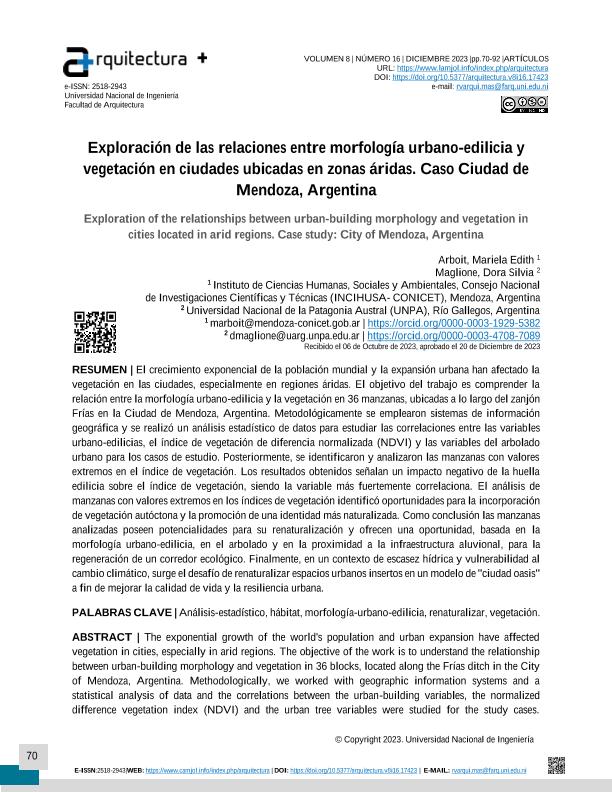Mostrar el registro sencillo del ítem
dc.contributor.author
Arboit, Mariela Edith

dc.contributor.author
Maglione, Dora Silvia

dc.date.available
2024-04-05T11:51:43Z
dc.date.issued
2023-12
dc.identifier.citation
Arboit, Mariela Edith; Maglione, Dora Silvia; Exploración de las relaciones entre morfología urbano-edilicia y vegetación en ciudades ubicadas en zonas áridas: Caso Ciudad de Mendoza, Argentina; Universidad Nacional de Ingeniería. Facultad de Arquitectura; Revista Arquitectura +; 8; 16; 12-2023; 70-92
dc.identifier.uri
http://hdl.handle.net/11336/232057
dc.description.abstract
El crecimiento exponencial de la población mundial y la expansión urbana han afectado la vegetación en las ciudades, especialmente en regiones áridas. El objetivo del trabajo es comprender la relación entre la morfología urbano-edilicia y la vegetación en 36 manzanas, ubicadas a lo largo del zanjón Frías en la Ciudad de Mendoza, Argentina.Metodológicamente se emplearon sistemas de información geográfica y se realizó un análisis estadístico de datos para estudiar las correlaciones entre las variables urbano-edilicias, el índice de vegetación de diferencia normalizada (NDVI) y las variables del arbolado urbano para los casos de estudio. Posteriormente, se identificaron y analizaron las manzanas con valores extremos en el índice de vegetación.Los resultados obtenidos señalan un impacto negativo de la huella edilicia sobre el índice de vegetación, siendo la variable más fuertemente correlaciona. El análisis de manzanas con valores extremos en los índices de vegetación identificó oportunidades para la incorporación de vegetación autóctona y la promoción de una identidad más naturalizada. Como conclusión las manzanas analizadas poseen potencialidades para su renaturalización y ofrecen una oportunidad, basada en la morfología urbano-edilicia, en el arbolado y en la proximidad a la infraestructura aluvional, para la regeneración de un corredor ecológico. Finalmente, en un contexto de escasez hídrica y vulnerabilidad al cambio climático, surge el desafío de renaturalizar espacios urbanos insertos en un modelo de "ciudad oasis" a fin de mejorar la calidad de vida y la resiliencia urbana.
dc.description.abstract
The exponential growth of the world's population and urban expansion have affected vegetation in cities, especially in arid regions. The objective of the work is to understand the relationship between urban-building morphology and vegetation in 36 blocks, located along the Frías ditch in the City of Mendoza, Argentina. Methodologically, we worked with geographic information systems and a statistical analysis of data and the correlations between the urban-building variables, the normalized difference vegetation index (NDVI) and the urban tree variables were studied for the study cases. Subsequently, blocks with extreme values in the vegetation index were identified and analyzed. The results obtained indicate a negative impact of the building footprint on the vegetation index, with the variable being the most strongly correlated. The analysis of blocks with extreme values in the vegetation indices identified opportunities for the incorporation of native vegetation and the promotion of a more naturalized identity. In conclusion, the blocks analyzed have potential for renaturalization and offer an opportunity, based on the urban-building morphology, the trees and the proximity to the alluvial infrastructure, for the regeneration of an ecological corridor. Finally, in a context of water scarcity and vulnerability to climate change, the challenge arises of renaturalizing urban spaces inserted in an "oasis city" model in order to improve quality of life and urban resilience.
dc.format
application/pdf
dc.language.iso
spa
dc.publisher
Universidad Nacional de Ingeniería. Facultad de Arquitectura
dc.rights
info:eu-repo/semantics/openAccess
dc.rights.uri
https://creativecommons.org/licenses/by-nc-nd/2.5/ar/
dc.subject
análisis-estadístico
dc.subject
hábitat
dc.subject
morfología-urbano-edilicia
dc.subject
renaturalizar
dc.subject
vegetación
dc.subject.classification
Otras Ingeniería del Medio Ambiente

dc.subject.classification
Ingeniería del Medio Ambiente

dc.subject.classification
INGENIERÍAS Y TECNOLOGÍAS

dc.title
Exploración de las relaciones entre morfología urbano-edilicia y vegetación en ciudades ubicadas en zonas áridas: Caso Ciudad de Mendoza, Argentina
dc.title
Exploration of the relationships between urban-building morphology and vegetation in cities located in arid regions: Case study. City of Mendoza, Argentina
dc.type
info:eu-repo/semantics/article
dc.type
info:ar-repo/semantics/artículo
dc.type
info:eu-repo/semantics/publishedVersion
dc.date.updated
2024-04-05T11:03:49Z
dc.identifier.eissn
2518-2943
dc.journal.volume
8
dc.journal.number
16
dc.journal.pagination
70-92
dc.journal.pais
Nicaragua

dc.journal.ciudad
Managua
dc.description.fil
Fil: Arboit, Mariela Edith. Consejo Nacional de Investigaciones Científicas y Técnicas. Centro Científico Tecnológico Conicet - Mendoza. Instituto de Ciencias Humanas, Sociales y Ambientales; Argentina
dc.description.fil
Fil: Maglione, Dora Silvia. Universidad Nacional de la Patagonia Austral; Argentina
dc.journal.title
Revista Arquitectura +
dc.relation.alternativeid
info:eu-repo/semantics/altIdentifier/url/https://www.camjol.info/index.php/arquitectura/article/view/17423
Archivos asociados
